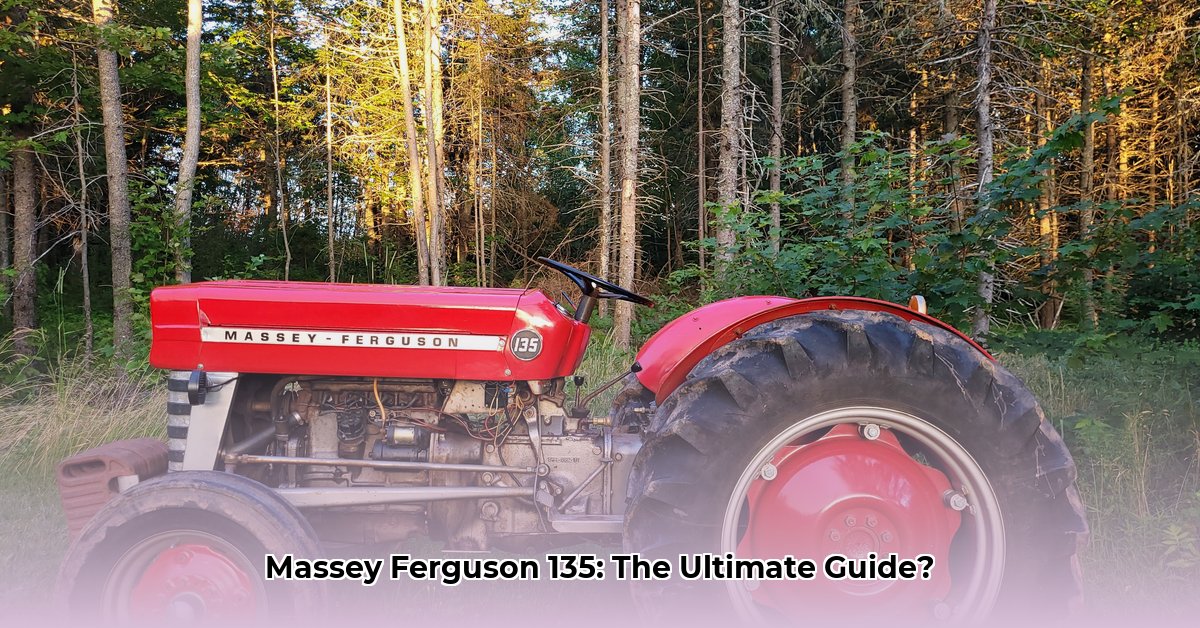
The rumble of a Massey Ferguson 135, the scent of diesel in the morning air – for many, these evoke a sense of timeless agricultural heritage. This iconic tractor, a workhorse of a bygone era, continues to captivate enthusiasts and practical farmers alike. But navigating the market for a used MF 135 requires careful consideration. This guide provides a comprehensive overview, blending historical context with practical advice to help you make an informed purchase. For even more information, check out this helpful resource: [Massey Ferguson information](https://tractor-massey-ferguson-new.pages.dev).
Tractor Massey Ferguson 135: Your Guide to Buying and Owning a Classic
The Massey Ferguson 135, produced between 1964 and 1975, isn't just a machine; it's a symbol of agricultural ingenuity. Millions were sold globally, a testament to its robust design and dependability. Its distinctive styling—a blend of practicality and understated elegance—remains instantly recognizable. Owning a Massey Ferguson 135 is about more than just acquiring a tractor; it's about inheriting a piece of history, a connection to generations of farmers.
A Piece of Agricultural History
From its introduction in 1964 to its discontinuation in 1975, the Massey Ferguson 135 quickly became a mainstay on farms worldwide. Its simple yet effective engineering, coupled with remarkable reliability, secured its legendary status. The MF 135’s enduring popularity is a testament to its design and functionality, making it a sought-after classic today. This isn’t just a tractor; it’s a piece of living history.
Navigating the Massey Ferguson 135 Market: Price and What Influences It
Pricing a used Massey Ferguson 135 is complex. Numerous factors influence its value, making it crucial to conduct thorough research. Think of it like the classic car market; condition reigns supreme. A beautifully restored tractor commands a higher price than a neglected one. Isn't it fascinating how condition impacts value so significantly?
- Condition: A meticulously restored MF 135, gleaming with pride, will fetch significantly more than one requiring extensive repair.
- Hours of Operation: Similar to car mileage, lower operating hours generally signal less wear and tear, leading to a higher value.
- Location: Regional differences in supply and demand, alongside local economic conditions, impact market price fluctuations.
- Optional Equipment: Added features like a front-end loader or a PTO (power take-off) significantly increase the tractor's value.
Assessing Your Potential Purchase: A Step-by-Step Inspection
Before committing to a purchase, a detailed inspection is paramount. This isn't a cursory glance; it's a meticulous assessment of the tractor's major systems.
Engine Evaluation: Check for leaks (oil, coolant, fuel). Listen for unusual noises—knocking, rattling—indicating potential wear or damage. A compression test provides a precise assessment of engine health. Consider this a critical first step.
Transmission Check: Shift through all gears, noting smoothness. Difficulty shifting gears suggests transmission problems, potentially costly to repair.
Hydraulic System Inspection: Inspect all hydraulic hoses and cylinders for leaks. Test the lift capacity; it should operate smoothly and with expected force.
Electrical System Examination: Test all lights, the battery, and wiring. Faulty electrical systems can present significant challenges.
Body and Structural Assessment: Check for rust, dents, and damage. Extensive rust can indicate underlying structural issues.
Test Drive (If Possible): Operational testing provides valuable insight into the tractor's performance and responsiveness. Addressing any observed abnormalities is important for informed decision-making.
Remember: a professional inspection by a vintage tractor mechanic is highly recommended.
Finding Your Perfect Match: Sources, Reputable Sellers, and Due Diligence
Finding your Massey Ferguson 135 involves exploring various avenues: online marketplaces (eBay, TractorHouse), dedicated agricultural equipment websites, local auctions, and classified advertisements. Engaging with online communities devoted to vintage tractors provides access to invaluable advice and potential leads.
Choose reputable sellers who are transparent about the tractor's history and condition. Don't hesitate to ask questions and request additional photos or documentation. Trustworthy sellers build confidence.
Negotiating and Finalizing Your Purchase: Price and Transportation
Research comparable sales to establish a fair market value. Negotiate reasonably, but don't be afraid to walk away from an unreasonable price. Factor in transportation costs; these can significantly impact your overall budget and should not be overlooked.
Ownership and Maintenance: Long-Term Care for Your Classic Tractor
Owning a Massey Ferguson 135 is a rewarding commitment, demanding regular maintenance. Routine oil changes, filter replacements, and regular inspections are essential. Finding a mechanic experienced with vintage tractors is invaluable.
Parts are available, though sourcing may require additional effort. Establishing a reliable source for parts is vital for keeping your tractor operational. This will prolong its lifespan and prevent unexpected downtime.
Technical Specifications (Illustrative Example - Refer to TractorData.com for Comprehensive Details)
| Feature | Typical Specification | Notes |
|---|---|---|
| Engine Horsepower | Approximately 45 HP | Can vary slightly based on model year |
| Drive Type | 2-Wheel Drive (2WD) | Common configuration for this model |
| Transmission | Gear-Type | Manual transmission |
| Fuel Capacity | Varies | Consult original manual or TractorData |
| Weight (Approximate) | Around 4,500 lbs | Can vary due to added equipment |
This guide provides a comprehensive starting point for buying and owning a Massey Ferguson 135. Thorough research, a pre-purchase inspection and realistic expectations are key to finding a classic tractor that will bring years of enjoyment.